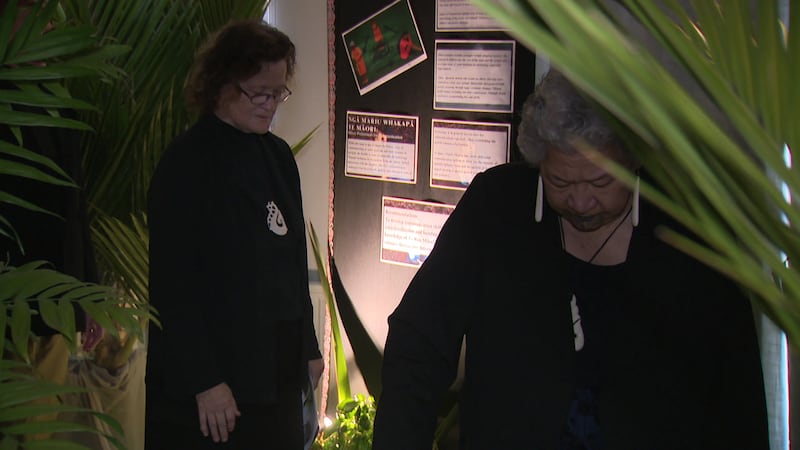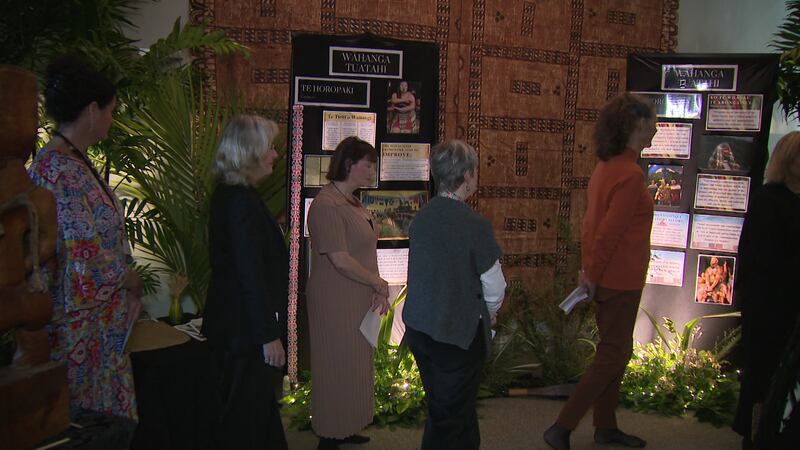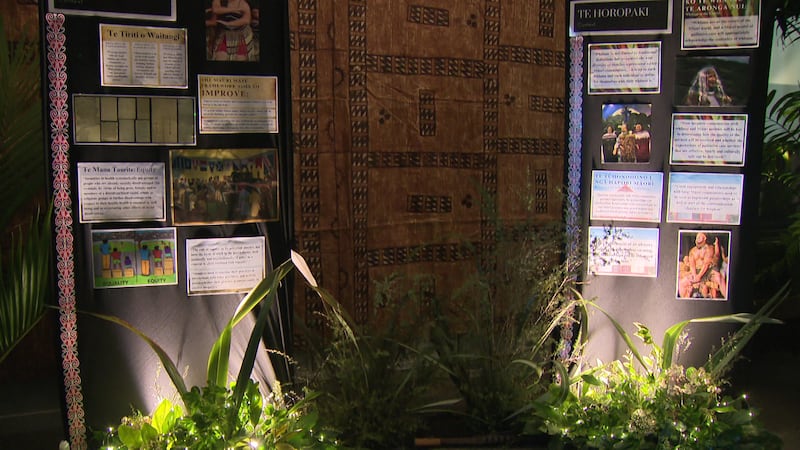Mauri mate, the Māori framework for palliative care, is described by kaimahi Māori as Te Tiriti o Waitangi in action.
Mercy Hospice, which is committed to Te Tiriti o Waitangi through partnership, participation and protection, recently hosted a private exhibition created by staff and educators, which hospice chief executive Emma Maddren said aimed to deepen connections and foster comfortability and confidence in the staff.
Te Ao News talked to Mercy Hospice’s pou Aatawhai Hera Pierce (Te Aupōuri, Ngāti Kahu, Whakatōhea, Whānau Apanui, Ngāti Porou,Te Aitanga a Mahaki) and the head of people and culture, Gwendolyn Arago‑Kemp (Te Whānau-a-Ruataupare, Ngāti Porou), who belong to Te Waka Atawhai - the Māori arm of Mercy Hospice.
Pierce said mauri mate was a framework created so their tākuta (doctors) and nēhi (nurses) could understand what had happened to the mauri of Māori people, and to know their responsibilities as tāngata Tiriti in how to treat Māori.

Dr Carol McAllum, a doctor at Mercy Hospice and its quality and partnerships director, said for too long and too often the health system, and its Western model hadn’t looked after Māori.
“It misses a lot, it tries and we really try, but there’s so much we miss,” McAllum said, “I don’t have the lived experience of the colonisation, what I see is impacts of the colonisation, but I don’t have the lived experience… so that’s why we’ve got mauri mate”.
“E mahi ana e tiaki te mauri ki te tatari i te ira kati o te hā.”
The work is caring for the life force of those waiting to take their last breath
— Hera Pierce
Gwendolyn Arago‑Kemp and Pierce said often Māori preferred to be at home or might be mataku (scared) to end up in places like the hospice because of cultural differences.
However, Mercy Hospice is hoping to educate and equip its staff with the skills to care for Māori.
Māori who come to them often struggle with poharatanga (poverty), kāinga kore (homelessness), mental health struggles, or where patients have been estranged from their family due to their takatāpuitanga.
“What we witness here in our hospice here in Ponsonby is they either come here with their whanau and hapū solidly behind them or come here with no one,” she said.
Pierce said a lot of urbanised Māori were disconnected from their home, disconnected from their marae, and in many ways were disconnected from their own people.
“What I know is there is no need to have a kino, horrible death, there is no need to have a painful death, there is no need to die alone.”
Non-Maori and Maori palliative care
Pierce said the difference in Māori palliative care was the depth as Māori - they were able to dive into many puna (springs) to gain knowledge, which were the gifts passed down by ancestors.
“Ko te rerekētanga te māori ki ērā atu tāngata whenua, ko te worldview” said Arago‑Kemp.
The difference between Māori and others in this country is our worldview.
“He rerekē hoki, ngā whakaaro o ngā tākuta me ngā nēhi ki te iwi Māori, nō reira he pai kia whaiako mō rātou ki te āta tiaki i ngā iwi māori.”
Another difference is the perspectives of doctors and nurses towards Māori, so, it’s good for them to learn how to take better care of Māori.
The exhibition on mate mauri
The staff and clinical nurse educators at Mercy Hospice took the lessons from the mauri mate book published five years ago and created an interactive exhition.
Arago‑Kemp said, “Ko te pūtake o tēnei whakaahuatanga kia whai akona e ngā kaimahi o tēnei wāhi mahi, nā te mea, i kitea mātou ki a rātou mōhiotanga ki ngā mea o ngā Māori, he iti noa iho tērā mātauranga ki a rātou. Nō reira he tino nui te pirangi a ngā kaimahi katoa ako ana i tēnei kaupapa.

The purpose of this exhibition is for kaimahi here to learn, because we saw they had limited knowledge on Māori matters, and all the staff have a real desire to learn about this subject.
McAllum said the exhibition was almost beyond words to describe. “What it brings is mauri. It brings spirit and it does it in an intangible way, and it does it in a way beyond words and I think that’s what mauri mate does.”
Although it wasn’t a public exhibition, Arago‑Kemp said it was something that should go further.
Mauri is the lifeforce ... it’s a gift that’s given to a human being for a minute passing in time.
— Hera Pierce
One of the staff previously worked at the University of Auckland’s medical school and he suggested the students should view the exhibition to add to their understanding.
The chief executive said the way the exhibition came about with kaimahi Māori and allies working closely together to foster deeper connections and understanding in how to work differently with Māori was beautiful.
And it was important tauiwi staff developed a comfort and familiarity in supporting Māori ways of being and doing because she thought sometimes people were a little fearful or reluctant, worried they might not get it right.
Advice for tauiwi afraid of getting it wrong
“My advice would be, that you’ll be embraced, guided and supported,” Maddren said.
In her experience, kaimahi Māori and whānau connected to the hospice really valued the efforts and understanding and supporting doing things differently.
“Have a go and do that authentically and thoughtfully and see that as making steps towards deepening your skills and your ability to create cultural safety.”

Maddren said what really struck her was seeing Māori within Mercy Hospice being fully, authentically and beautifully Māori and trusting the beauty of te ao Māori and mātauranga Māori.
McAllum said she had learned “there’s a lot more beyond what we see and hear and beyond our bodies and beyond all the focus on our physicality, there’s a lot more”.
“For me, that’s what Te Ao Maori speaks to, it speaks to the world in which we live and beyond”.
Te Ao Māori News asked her as a physician whether that was an interesting journey and in response she said it was “sobering”.
“I’ve spent many years trying to fine-tune how to control physical symptoms and things like that, and I know as well that our symptoms are manifestations of things that are not physical a lot of the time. I spent a lot of time getting drugs right but it’s more than that and I don’t think our medications can speak to those things.”


